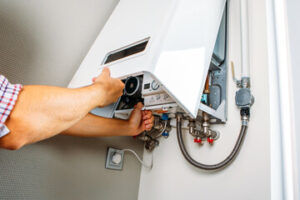If your water heater isn’t working right, you may need to get it repaired or replaced. The cost of a water heater repair depends on the part or components that are broken and the labor needed to fix them.

If you need to have a water heater repaired, it’s always best to call a professional plumber like Cincinnati Water Heater Repair. This way, you can be sure your work is done safely and efficiently.
Water heater thermostats work by regulating the power that runs through the heating element in your water tank. They also sense when the temperature of the water in the tank is too low and shut off the electricity to the heater. If your water heater is unable to heat up enough water, you may have a defective thermostat.
The thermostats are not too expensive to repair, but they should be replaced if they’re malfunctioning. If you’re unsure about whether your water heater needs a replacement, you can call a professional to come out and give you an estimate.
To test your water heater thermostat, first turn off the power to the heater and disconnect the wiring. Next, use a multimeter or voltmeter to test each wire and make sure the terminals have continuity.
If you don’t have a voltmeter or multimeter, you can purchase one at most home improvement stores for under $50. Be careful when testing the thermostat, as you could become electrocuted if you accidentally touch a live wire to a non-live wire.
Depending on the type of thermostat your water heater has, you may need to remove a safety cover in order to access it. If you do, follow the instructions for your model and unscrew it using a flathead screwdriver.
Once you’ve uncovered the thermostat, you should be able to see it easily. If you can’t, you should call a plumber to check out the thermostat for you.
A good plumber will be able to double-check your inspection work and root out any other problems that may be contributing to the issue you’re experiencing. They can help you get your water heater running efficiently again so you don’t have to worry about a faulty thermostat again.
If your water heater is still a bit hotter than you want, try adjusting the temperature dial to be cooler or warmer than the current setting. After doing this, you can retest the temperature to ensure you’ve made the correct adjustments. If the hot water is still not at the desired temperature, repeat these steps and adjust again until you reach the desired level of warmth.
If you have a gas water heater, you may have noticed that it doesn’t produce hot water as often as you’d like. This could be because you’re unable to light your pilot light, or it might be due to a bigger issue that will require professional help.
The pilot light is what enables your gas water heater to ignite the fuel that’s supplied by your tank. If the flame goes out, it’s usually due to a few common reasons, including a dirty or malfunctioning gas valve or a leak in your tank.
A healthy pilot light should be blue in color. If it is yellow, red, or orange in color, it indicates that there’s dirt or other debris that’s causing the flame to burn unevenly. This can be fixed by cleaning out the pilot tube and giving it a good scrub.
Another cause of a faulty pilot flame is an issue with your thermocouple, which regulates the amount of gas flowing into the burner. A faulty thermocouple can shut off the flow of gas and prevent your pilot flame from working correctly, so it’s important to replace it as soon as possible.
Depending on the model of your water heater, you might need to disassemble it to access the pilot light and thermocouple. This is a fairly simple job, but if you don’t have the proper tools or skills, it might be best to call a plumber instead.
You might also need to adjust the flame height on your pilot valve, which is located on the inside of your water heater’s body. There’s usually a small screw that you can turn to adjust the height of the flame.